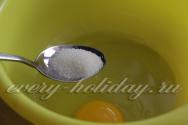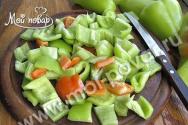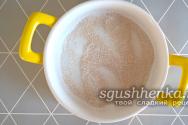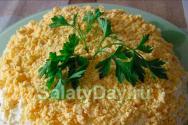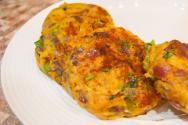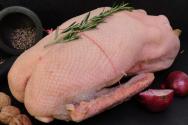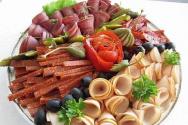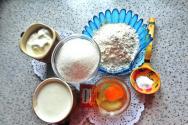Traditional types of bread and pastries in Japan. Japanese milk bread "Hokkaido" Step-by-step preparation of Japanese bread "Hokkaido"
This bread recipe originated on the northern Japanese island of Hokkaido. There, unlike the rest of Japan, there is enough space for growing wheat and raising cows. Dairy products from Hokkaido are the best in Japan. And the bread recipe was invented to highlight the beauty of high-quality milk and butter. The airy, porous crumb and slightly sweet milky taste captivate you from the first bite.
This bread is a favorite in our family. I cook it very often. It is perfect for both sweet and savory sandwiches, for croutons, and is even very tasty to eat just like that.
I want to admit right away: kneading dough for milk bread by hand is a long and labor-intensive process, so I adapted to baking it in a bread machine.
First, I sift the flour into a bowl.
I measure out all the necessary ingredients.
Sugar:

Salt:

Oil, measure out the required amount and wrap it in film:

Yeast:

I heat the milk a little.

Add all the dry ingredients to the flour and mix.

I knead the butter directly in the film to a plasticine-like state. It should be very soft so that it can be easily mixed into the dough, but it should not start to melt or flow.

Pour the dry mixture into the bowl of the bread machine.

I add milk there.

First, I knead the dough for a short time, 2-3 minutes. At this stage, it is enough for all the products to simply combine into one mass.

I add oil and knead more thoroughly until the dough becomes homogeneous. This process takes 10 minutes.

I leave the dough to rest for 20 minutes.
I knead for 10 minutes, rest for 20 minutes, and so on 3 times.
The result should be a very homogeneous, elastic, glossy dough.

Now you can leave it for the first proofing for 1 hour.
Then I knead and release carbon dioxide.
Again I leave it to rise for an hour.

I bake the risen dough for 40-45 minutes. If you bake in the oven, you need to preheat it to 200 degrees Celsius and bake for 40-45 minutes. If the crust starts to burn, you can cover it with foil.
I take the finished bread out of the mold and leave it to rest and cool slightly. The smell is incredible throughout the entire area. No one will refuse a hot crust of freshly baked bread, but I don’t recommend cutting bread while it’s hot. In hot bread, the baking process has not yet completed and the crumb is unstable; if you cut it with a knife, it will crumple, crumple and will not straighten out. I let it cool and you can cut it however you like.

Bon appetit!

Cooking time: PT05H00M 5 h.
Approximate cost per serving: 70 rub.
Everyone knows that the main food in Japan is rice. How are things going with bread here? Which bakery products should a tourist visiting this amazing country try? What will a student who stays on a long-term program have to miss? So, in our article we will talk about Japanese bread!
The Japanese word for bread is パン (pan), and it came to Japanese from Portuguese. Having borrowed the word, the Japanese filled it with a new, original taste. It was various types of bread that became characters in the popular children's anime Anpanman (「アンパンマン」).

So, what is the most common Japanese bread? It is called 食パン (しょくぱん, shyoku pan): the first character means “to eat”, that is, bread that is eaten. This is how the hero Shyokupanman (しょくぱんまん) is presented in the anime.

This is a square piece of toast bread, cut into a certain number of slices.

It is curious that the “length” of the bread package is the same everywhere, but the number of slices into which the bread is cut may differ in different cities. For example, in Osaka they sell bread cut into four, five or six slices. And in Tokyo they like thinner bread - there will be eight slices.

Do you remember what counting suffix you need to use to count the slices of bread? Slices are so-called “flat objects”, so the suffix 枚 (まい, mai) is suitable for them.
Bread is not very cheap by Russian standards. You will be lucky if you can find bread for 100 yen (about 50 rubles), it can cost one and a half times more.
Japan has a poorer range of cereal crops compared to Russia, so bread porridge is a common dish for babies just starting to get acquainted with solid food. In this regard, almost all packages of bread contain allergens included in its composition. Typically these are the ingredients found in milk (乳成分 / にゅうせいぶん, nyu:seibun) and wheat (小麦 / こむぎ, komugi). By the way, remembering the word “allergy” is very easy. It is borrowed and sounds almost the same as in Russian: アレルギー (arerugi:).
Our next “bread anime” hero is Currypanman (カレーパンマン).

Can you guess what the bread will come with? That's right, with curry! Probably, many of our readers love aromatic sauce with vegetables, and when all this is wrapped in dough reminiscent of Russian belyashi!.. You simply must try it! Moreover, the price of a curry bun is quite attractive - about the same 100 yen.


Meronpanna chyan (めろんぱんなちゃん) is a favorite heroine of Japanese girls.

Do you remember what the anime itself is called? "Anpanman"! What is this “an”? What vegetable or fruit does this word mean?

餡 (あん, an) is a sweet bean paste, a popular delicacy included in many types of 和菓子 (わがし, wagashi) - Japanese sweets. Its taste may seem somewhat cloying, but if you like this sweetness, then you will definitely like buns stuffed with bean paste, あんパン (anpan).

In addition, you can find the word “pan” in the names of such types of bread as: ピザパン (piza pan) - pizza-flavored bread, カニパン (kani pan). Kani means "crab" (蟹) in Japanese, but kani pan isn't crab-flavored bread, it's crab-shaped buns - another favorite treat for Japanese children.

These buns are also unique in that in the process of eating them, the crab can become a variety of shapes: from rock-paper-scissors to a butterfly or a man.

So, we talked to you about unique Japanese pastries that you can only try in Japan. How are things going here with the bread familiar to the Russian heart? Is it possible to find it somewhere?
Unfortunately, black bread exists here only in dictionaries. Those of our readers who have already learned the names of flowers will probably be able to create this phrase themselves: 黒パン (くろぱん, kuro pan) - black bread. In fact, in stores you can see grayish, brownish bread, but not our black bread. That is why at Russian fairs in Japan Borodinsky’s loaves, sold at exorbitant prices, sell with a bang. If you wait too long before the fair or travel too far, you can go to a Russian restaurant. True, the prices are very steep there too. So, in a Russian restaurant in Osaka, black bread costs 400 yen (about 200 rubles).

For obvious reasons, you won’t find analogues of our “Seven Crusts” and “Kirieshki” on the shelves of Japanese supermarkets. There are, however, croutons for making Caesar salad. These croutons are called クルトン (kuruton), and the salad itself is called シーザーサラダ(si:za: sarada).

There is also an expression 白パン(しろぱん, shiropan) – “white bread”, but it is also more suitable for Russian restaurants, since, we repeat, all Japanese bread is almost white. However, in a sense, the Russian loaf is more fortunate - sometimes it can be seen on the shelves of ordinary supermarkets. This delicacy is calledロシアパン (roshia pan), that is, Russian bread. True, it is Russian more in shape than in taste: the dough is a bit sweet for ordinary bread, and the crusts are not at all crispy.

By the way, do you know how to say “humpback” in Japanese? パンの耳(ぱんの耳、pan no mimi). 耳(mimi) means “ear, ears,” that is, for the Japanese, the hump is the ears of bread. Cute, isn't it?
This concludes our story about Japanese bread. Write in the comments what you tried in Japan from what was described in the article, tell us about your favorite baked goods!
And finally, a task for those who want to test themselves. This time we offer them in test form.
Exercise
Read the question and choose one correct answer.
- What kind of bread will you buy if you want to eat something sweet?
A.ピザパン B.メロンパン C. カレーパン
- Which of the following products is not an allergen in toast bread?
A. 乳成分 B. 蟹 C. 小麦
- In which city can you buy bread cut into eight slices?
A. Tokyo B. Kyoto S. Osaka
Hokkaido is Japanese bread made with milk. The recipe and technology for preparing Japanese bread is original and has secrets.
This bread recipe uses tempered milk. It’s easy to make – heat the required amount of milk to 85-90 degrees and pour it into a thermos. Leave for 30-40 minutes, then pour into a mug and add butter.
The milk should now gradually cool to room temperature. This preparation improves the taste of the bread; it turns out almost rich, with a pronounced creamy milky aroma and does not go stale for a long time.
Ingredients
- tempered milk – 0.5 cups (125 ml)
- warm water - 0.5 cups (125 ml)
- white sugar – 1 tbsp. l.
- table salt – 0.5 tsp.
- butter – 20 gr.
- pressed yeast – 20 gr.
- wheat flour – 400 gr.
- a little vegetable oil to grease the pan
Preparation
Big photos Small photosHeat the milk almost to a boil (so that a film forms) and immediately, without allowing it to cool, pour it into a thermos. Leave for 30-40 minutes.

After the specified time, pour the milk into a saucepan or mug, add water, stir and add butter. The milk should now gradually cool to room temperature.

Crumble the compressed yeast into a bowl.

Add sugar and salt there. Pour in the cooled milk and butter, stir until the yeast dissolves. Add 2 cups of sifted flour. Stir flour with milk and yeast.

Add another half cup of flour until you get a viscous, lumpy mass.

Place the dough on the table. Add flour only if necessary - the dough is unlikely to take more than 400 grams. Knead it until smooth and soft. When you feel air bubbles under your hands, this means the dough is well kneaded and you can set it to rise.

In the heat, the dough will rise for about 1.5 hours and during this time it will grow at least three times.

Punch down the dough. Divide into 3 equal-sized pieces. Using your hands, stretch each piece into a rectangular layer (about 1 cm thick).

Fold one side towards the middle. Press the edges.

Wrap the other side in the same way. Press down the edges lightly.

Roll each strip of dough into a log. There is no need to pinch the edge.

Place the rolls in the pan (grease it generously) seam side down. Leave a small distance between the rolls - the dough will rise well.

Cover the pan with film and let it proof for 35-40 minutes. The dough should rise to the level of the pan.

Place the bread in an oven preheated to 200 degrees. Bake on the middle tier for 15 minutes, then reduce the temperature to 180 degrees. Move the bread to the top tier and bake for another 15-20 minutes.
Remove the finished bread from the mold immediately to prevent it from becoming damp, cool under a towel on a wooden board or on a wire rack.

The bread needs to be allowed to stand for at least 2-3 hours, “rest”, and only then can it be cut and tasted.
The recipe for Hokkaido milk bread has appeared on the Internet for a very long time. But unfortunately, I don’t know Japanese in any of the many languages that I can read; I couldn’t find any information about where exactly this bread came from, or what the history of its origin is. However, he looks so seductive that I just couldn’t resist. Despite the main consumption of rice and noodles, it is not uncommon to find bakeries and “Western” bread in Asian countries. In many Asian countries, this is part of the colonial past, and in some it is simply a fashion for everything “Western”. Therefore, it is very possible that Hokkaido milk bread is actually related to Japan and its island of the same name, which is famous for its dairy products. This bread is very airy and light and if it had more sugar, it could be called a bun.
Thanks to the method of brewing flour, called Tang Zhong, and a special method of shaping, by rolling out the dough, folding and twisting, Hokkaido milk bread is very soft and doughy. All children will definitely be delighted, adults will also not be able to deny themselves a piece of such bread, greased with butter and their favorite jam :-).
Although the method is called Tang Zhong, brewing flour for bread is by no means new and is very common. For the first time I practiced brewing like this for cooking. Traditional Lithuanian rye bread is also baked from flour that is partially boiled. It is not known who was the first to practice this method. For many Asian dumplings (wontons, gyoza, etc.) and pancakes (like), flour is poured with boiling water. And given the antiquity of Asian cuisine and its development in ancient times, it is very likely that this dough preparation technology came from there. One way or another, the method is definitely worth attention.
Hokkaido milk bread dough is moderately sticky and that's how it should be. And in order not to add excess flour when kneading, you should grease your hands and work surface with oil. This will not harm the test and it will be much easier to work with.
The characteristic rolling and folding of Hokkaido milk bread dough rolls aims to stretch the gluten in the dough, which makes the overall texture of the bread's flesh more uniform and more elastic. Therefore, this step is very important and directly affects the quality of the baked bread.
1) Work in a draft-free room;
2) Preheat the oven thoroughly before inserting the pan with bread into it;
3) Do not open the oven for the first 15 minutes of baking so that there is no temperature difference in the oven;
4) Before slicing, be sure to leave the bread to cool completely, otherwise even well-baked bread, cut before cooling, will be lumpy.
Enjoy your bread and enjoy baking!

For brewing Tang Zhong:
- 100 ml milk
- 20 grams of flour
For the test:
- 150 ml milk
- 2 tbsp. Sahara
- 15 grams of fresh yeast
- 400 grams of flour
- 1 egg
- 1 tsp salt
- 10 grams butter
additionally:
- 1 egg
- 2 tbsp. milk
- Butter for greasing the pan
- Boroshno for posipannya formi
- Vegetable oil for lubricating the work surface
1) Prepare Tang Zhong tea leaves. To do this, place the milk and flour in a small saucepan and put on low heat. Heat, stirring constantly until the mixture thickens. Remove from heat, add butter, mix well and leave until cool.
2) Heat the milk a little, add sugar and yeast. Stir well until the yeast is completely dissolved.
3) Place milk with yeast, egg, salt, flour and Tang Zhong tea leaves into the bowl of a planetary mixer or deep bowl. Knead on low speed for 5 or 10 minutes with your hands. When pressed, the dough should return to its original shape. This means it has been kneaded well.
4) Cover the dough with a slightly damp towel or cover the bowl tightly with cling film and leave to rise for about 1.5 hours at room temperature. The dough should double in size.
5) Grease a rectangular bread pan with a thin layer of butter and sprinkle with flour. Shake out excess flour.
6) Knead the risen dough and place it on a work surface greased with a thin layer of vegetable oil. Grease your hands with vegetable oil and divide the dough into 3 equal parts.

Someone once asked me on Instagram if I had already made Hokkaido bread. But the fact is that traditionally no one here likes Japanese bread - it’s too white, soft, fluffy, fluffy, and sometimes it even happens that you fry it - and it’s impossible to eat it when it’s cooled, it’s so... not good. When fresh it’s like cotton wool, when it’s stale it’s like cardboard, there’s no life or pleasure in it. But in May I bought a book by a Frenchman who has worked in Kobe all his life and laid the foundation for a network of bakeries throughout Japan. Among his recipes, of course, there is also bread in the form the Japanese love it. It is this, and not a baguette or ciabatta, that is sold everywhere, in any village, in any convenience store, in a drag store... in general, when they say “bread”, the Japanese mean this
In Japan it is simply called shokupan, table bread, so to speak. But I have never come across “Hokkaido bread”; there is simply no such name. Bread of this type can be with a pot-bellied crust or strictly 4-cornered (if baked in a closed form), can be long or almost cubic in shape, and can be sold already cut into slices. It also comes with the addition of a small amount of whole grains, whole grain or rye flour. But he is always very soft. And if we talk about Hokkaido, then this bun most likely comes to mind - a cheesecake with an image of the island. It makes me acutely nostalgic, because I tried it in the first hours of my stay in Japan :))) But it contains some monstrous amount of calories, so since then I have hardly eaten them)))

Hokkaido is actively developing the traditions of growing wheat and making flour, borrowing technologies from countries that are more advanced in this regard, in particular Canada. I haven’t baked with Hokkaido flour yet, I always reach for French flour, but someday I’ll try. And now I want to give you a recipe for Japanese bread from Mr. Bigot, it does not contain eggs, honey and other ingredients that I see in non-Japanese recipes, and which are clearly superfluous. The only unusual ingredients here are milk and butter. Watching how the child made bad, but soft store-bought bread without crusts, I tried to bake it at home, and what a miracle - they eat it no worse than our rougher bread.

The recipe is for 2 loaves with a format of 32x10.5x11.5 cm, this is a lot, I take half and it turns out to be one big loaf.

Lys d`Or flour - 500 g. This is French baguette flour, quite white, it produces fluffy and aromatic dough. My Japanese sources say that baguettes are made with medium gluten flour, not the strongest and not the weakest.
Super King flour - 500 g. You can use regular high gluten flour. I think you can generally try to take only 1 type of white flour, with a protein amount of about 11.7-12%, nothing fatal should happen.
Powdered milk - 50 g
Regular milk - 200 g
Water - 540 g
Fresh yeast - 7 g
Dry instant yeast - 7 g
Sugar - 40 g (too much for our taste, need to be reduced by half)
Salt - 20 g
Unsalted butter - 60 g
The butter is added in the middle of the kneading in a soft form.
Fermentation - 2 hours, after the first hour the dough must be kneaded. I keep the dough at a temperature of 35 degrees and for a little longer than indicated in the recipe. It is not necessary, in my opinion, to strictly maintain the temperature, it’s just that at 25-27 degrees it will take more time, and with such an amount of yeast the dough has no chance of not rising.
Remove the dough from the container, relax on the table for 20 minutes, then cut. You can twist a rope from 2 parts of dough and place it in a rectangular shape, then the bread will turn out with interesting stains on the surface. You can divide the dough into 4-5 round buns, they will merge in the mold, there will be a beautiful top, and it is convenient to divide into parts.

Proof for 60 minutes, the dough will increase in size by about 8 times, as written in the book. For half the recipe, I took a large mold, although I really doubted it, the bread fit perfectly into it. At the beginning of the proofing, the dough filled probably a fifth of the mold, no more.

Baking: 200 degrees, 45 minutes. Nothing is said about steam, but I added the first 10 minutes; if it is baked with the pan lid closed, then, logically, steam is not needed.
